The NVIDIA SHIELD Tablet Review
by Joshua Ho on July 29, 2014 9:00 AM EST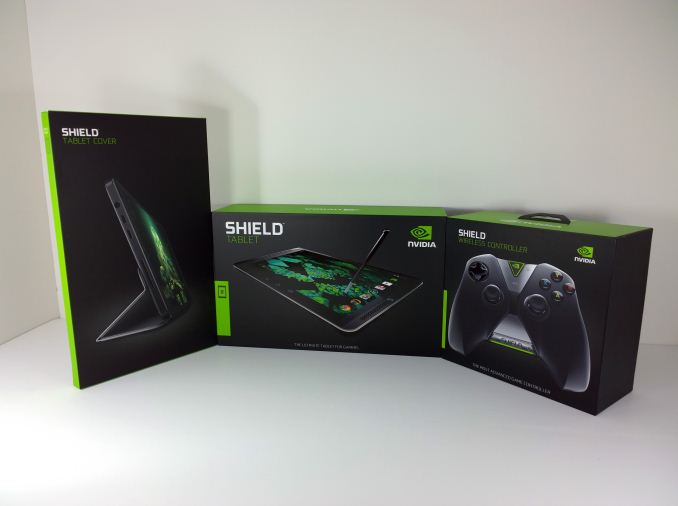
As I discussed in our launch article last week, the Shield tablet is very much the culmination of lessons learned from 2013. While the Tegra Note 7 was a decent tablet, it had to eke out a profit through hardware sales against competition that was willing to sell their tablets with no profit on hardware. Meanwhile the Shield portable was a good portable gaming device, but it was far too specialized to be anything but a gaming device. Without an established gaming ecosystem, NVIDIA struggled against established competitors.
As a result of these influences, today NVIDIA is becoming the first OEM to launch a serious gaming tablet running Android. While gaming tablets have been done before, they’ve been few and far between. Now it has always been technically possible to take a high end tablet and make it usable for gaming, but for the most part these attempts are marred by either the need for root or an application that requires extensive work on the part of the user to create proper control profiles for each game. In addition, the SoC in the tablet is often underequipped for intensive 3D gaming.
That’s where the Shield tablet comes in. With Tegra K1, a dedicated controller, 2x2 WiFi, and a huge amount of custom software, there’s definitely a lot of ground to cover. Once again, while the Shield tablet is a gaming device, it must also be a good tablet. To that end, NVIDIA has tried to differentiate this tablet with DirectStylus 2 and dual front facing speakers/bass reflex ports. I’ve included a table of specifications below to give a general idea of what the tablet is like.
| NVIDIA Shield Tablet | |
| SoC | Tegra K1 (2.2 GHz 4x Cortex A15r3, Kepler 1 SMX GPU) |
| RAM/NAND | 2 GB DDR3L-1866, 16/32GB NAND + microSD |
| Display | 8” 1920x1200 IPS LCD |
| Network | N/A or 2G / 3G / 4G LTE (NVIDIA Icera i500 UE Category 3/4 LTE) |
| Dimensions | 221 x 126 x 9.2mm, 390 grams |
| Camera | 5MP rear camera, 1.4 µm pixels, 1/4" CMOS size. 5MP FFC |
| Battery | 5197 mAh, 3.8V chemistry (19.75 Whr) |
| OS | Android 4.4.2 |
| Connectivity | 2x2 802.11a/b/g/n + BT 4.0, USB2.0, GPS/GLONASS, mini HDMI 1.4a |
| SIM Size | None or MicroSIM |
| Price | $299 or $399 (16GB/WiFi or 32GB/LTE) + $59 (optional controller) |
Hardware
Outside of the basic specs, the tablet itself has a much more subtle industrial and material design. While the large speaker grilles are maintained from the Tegra Note 7, the dimpled look and feel is gone. Instead, the finish is very much reminiscent of the Nexus 5. The feel isn’t quite rubbery the way soft touch finishes tend to be. Instead, it feels more like a high grain matte polycarbonate. Along the sides, there’s a noticeable chamfered edge where the back cover meets the display, although in practice this mostly affects aesthetics rather than in hand feel. The flip cover that is designed for the device is almost identical to the one in the Tegra Note 7, and folds up similarly. As with the Tegra Note 7, there are two angles that the flip cover can take. Overall, the aesthetic is much more subtle than the Tegra Note 7, and looks quite similar to the Nexus 7 (2013).
While it’s important for the tablet portion of the device to have decent material and industrial design, ergonomics and material design are critical for the controller. While the Shield portable had great ergonomics, it was heavy because the entire device had to fit in the controller. With Shield Tablet, that’s no longer the case. The result is that the controller is significantly lighter. While it still has some heft to it, I no longer feel the need to rest my hands against a table after significant playtime.
The controller itself is just as good as the one on the Shield Portable. The buttons, triggers, bumpers, and joysticks are all very close in feel. The one big difference are the tablet/Android controls. Instead of physical buttons, they’ve replaced the physical buttons with capacitive ones. The volume controls have also been moved down to the bottom of the controller and changed from a single button that triggers on-display volume controls to a rocker that allows direct manipulation of volume. Just above the volume rocker is a clickpad, which can be used to move a cursor through the UI. While this option exists, it’s a bit unpolished as the sensitivity isn’t tuned quite right to quickly navigate through the tablet.
Of course, there’s more to the controller than just the buttons and controls. NVIDIA has made sure to do things right by using WiFi Direct for communicating between the controller and the tablet. The frequency used depends upon what access point the tablet is connected to, so it can switch between 2.4 GHz and 5 GHz as necessary. NVIDIA claims that using WiFi Direct instead of Bluetooth drops latency by half, and also allows for microphone input and sound output via 3.5mm jack through the controller. In practice, the controller works great. I don’t have any complaints about this at all. Pairing is as simple as pressing and holding on the NVIDIA logo for a few seconds, then opening the pairing application. Up to four controllers can be paired to the tablet this way, which introduces interesting possibilities for local multiplayer games such as Trine 2. I also didn’t notice a difference in response time of the wireless controller when compared to the wired controller of Shield Portable. It’s incredibly important to get the controller right for gaming devices, and NVIDIA has nailed it. Overall, I’m happy with the basic hardware for both the controller and tablet. While it would be interesting to see a metal unibody design on the tablet, it’s difficult to justify at the price point that this device has to hit.
Of course, while hardware is important, software makes or breaks this tablet, so that’s next.


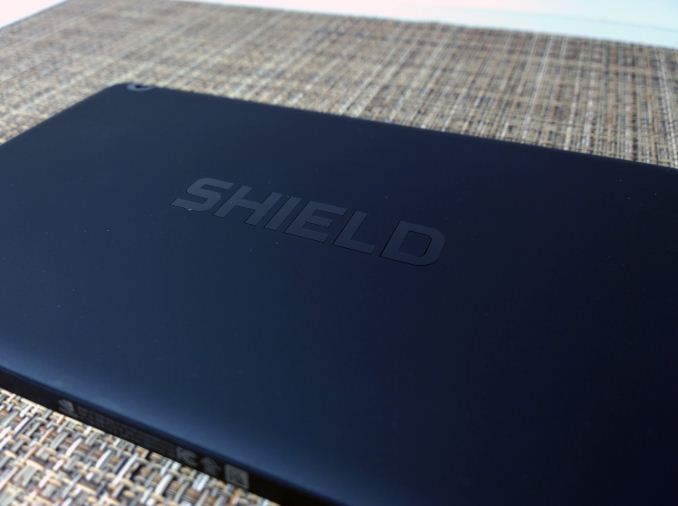
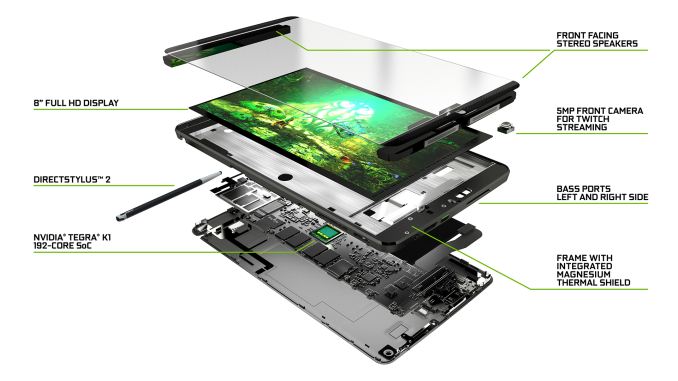
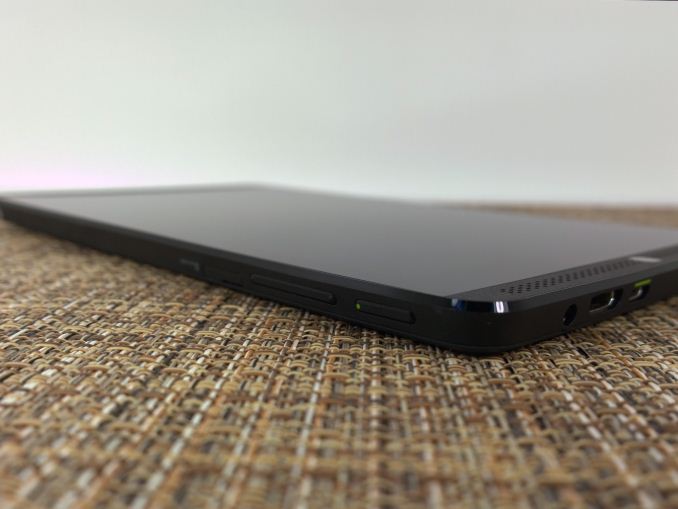
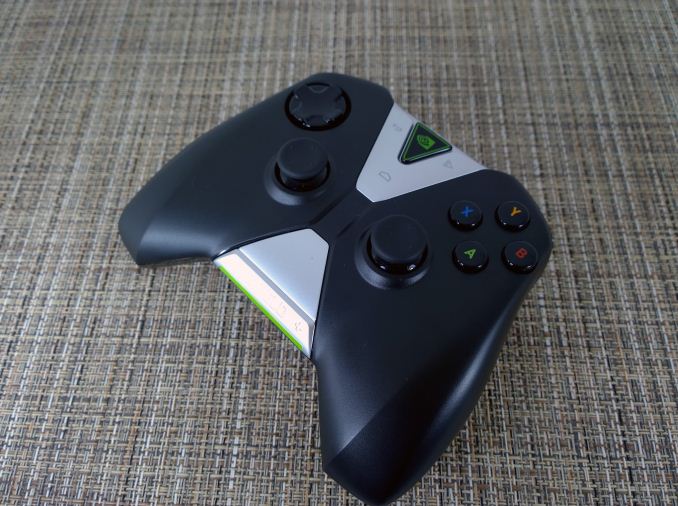








174 Comments
View All Comments
Wolfpup - Tuesday, July 29, 2014 - link
Wish it had a larger screen. I'd really love a 12" screen for graphic novels and magazines, but I at least want 10".Regarding Half-Life...it's awesome it runs on this, but super lame it I guess REQUIRES Nvidia hardware to run? Android's already a big enough mess as it is. I don't need programs that only run on some and not all Android devices.
Wolfpup - Tuesday, July 29, 2014 - link
I wonder about the controller too...it seems very nice, but wondering if it'll work with PC games or iOS for that matter.vision33r - Tuesday, July 29, 2014 - link
Those of us that owned the 1st gen Shield love it because of the portability and form factor. I am able to use it on the train or plane easily like a NDS. This thing now requires that I put it on the dock or stand.I think they would be better off releasing a Shield with 5.7" display edge to edge instead of the big border.
I can play most games like Skyrim on a 5" display well just annoyed by the border.
chizow - Tuesday, July 29, 2014 - link
If you listen to the MaxPC webcast with Tom Petersen, I think there is a very good chance we see an updated Shield Portable 2. Not sure about a bigger screen, I'd get one too if it had a 6" 1080p screen and TK1, but there's a good chance it has its SoC updated. I am 99% sure Nvidia said TK1 is pin compatible with T4, so it would be an easy upgrade.TheJian - Wednesday, July 30, 2014 - link
Agreed, shield r2 is coming. They have said recently they serve different markets (and they do). There was no mention of it not being revved yearly and specs are out for 4GB, 1440x810 etc. That is no where near this device and seems likely a perfect update to Shield 1 and more geared towards handheld hardcore gamers. Shield was only 10mil to develop, so plopping in K1 shouldn't be much more if they stick with the same design etc, just amp a few things up (memory etc). No need for a massive redesign it was already good. Sticking with 720p or just above should save on power also, again more in line with a handheld usage playing games. MHL 3.0, usb 3.0 and support for a large SD card is all I'd need to jump I think.They said K1 32 and 64 Denver K1 is pin compatible, but not T4. But that's not a huge redesign considering the whole thing only cost 10mil the first time. They only needed to sell about 100K-150K to break even probably (assuming $100 or so profits for each sold based on ~160 vita cost, and 101 for 3ds BOM at launch for them). Everything from Vita/3ds got shrunk so costs are probably similar.
GC2:CS - Tuesday, July 29, 2014 - link
When nvidia had showed its prototype Kepler mobile GPU for the first time for examination here on anadtech I was excited as it showed it was drastically more efficient and faster than the king of mobile GPU's at that time the A6X. It just kind of blew it away, even though Apple really gone wild when talking about SoC's: a custom CPU architecture, a GiGantic GPU, huge amounts of bandwidth etc. But with such Kepler GPU they could afford to wait for a year and still beat everyone at least in theory.But in reality ? A year after Kepler prototype, we have well.... two tablets and an all in one ? And after a year even the power and performance story doesn't look as good as interpreted by nvidia.
After a year we got the new Apple A7 that nVidia claimed about that their new K1 is 3x faster and 50 % more efficient.
Lets compare them now.
A7 gets 13 fps in manhattan and K1 over 30 fps, but still well short of 3x which is.13by3...wait...... about 39 fps. So about 2,4 times faster in comparison, still nice.
Then there is efficiency. Running down a 19.75 battery in 2.2 hours with a display that consumes AT MOST 1,46 W at 200 nits yields an power consumption of all other components of AT LEAST 7,3W (most of that is the SoC+RAM) which is downright ridiculous. Then there is throttling. Maybe it doesn't look significant on that chart, but it reached vsync in first dozen runs. Taking into consideration off screen tests, without vsync it would run at about 63,5 at native resolution and it would start throttling sooner. Now going down to 46,1 thats a difference of 27%. Still nice for so many runs, but not all tablets have dedicated magnesium heat spreader installed in them and I don't think it will be problem for a gamer to play a PC game port for 70 minutes or more non-stop. But the bad thing is that it throttles even with that heat spreader, and that means its really hot.
And now lets compare with A7. Its got far far lower power compustion under full load and also generates far less heat, so it the GPU doesn't throttle at all. Taking this into consideration, the tegra can be less than 2,4 x the A7, especially in tablets without custom heat spreaders and after prolonged use. And ouch a phone ! You can put the A7 into a phone ! And the GPU doesn't throttle at all as well. And then the A7 is 10 months old chip and still tegra has a hard time even in terms of efficiency. The A8 will be entirely different league, it will crush tegra, not it performance, but in efficiency.
Considering all of this it just kind of dissapoints me.
identity - Tuesday, July 29, 2014 - link
iSheep trying to spread that Apple propaganda lol! Nice try though :)melgross - Tuesday, July 29, 2014 - link
The fact that you feel the need to use that word just shows that your thinking is very limited. If you have something useful to say, try to refute what he said instead. Stop acting as though you're 12 years old.ams23 - Tuesday, July 29, 2014 - link
Mobile Kepler in Tegra K1 is roughly 50% more power efficient than G6430 in A7 with GFXBench 3.0 Manhattan Offscreen test: http://images.anandtech.com/doci/7622/Screen%20Sho...Regarding throttling, there is virtually no throttling on Shield tablet until after 115 (!) runs: http://images.anandtech.com/doci/8296/TRexRunDownG... . You can see that Onscreen fps only varies by a couple fps during that time.
As for battery life, Shield tablet has a battery saver mode which should result in superior battery life for gaming.
At the end of the day, mobile Kepler can reach performance levels and playable settings that other thin fanless tablets currently on the market cannot even hope to reach. I would much rather have 3 hours of smooth and playable gameplay at 30-60fps than 5 hours of non-playable gameplay at 15-25fps.
melgross - Tuesday, July 29, 2014 - link
That's very true. But this is a new chip, and the A7 is now becoming an old chip, by the standards of mobile development. It will be interesting to see whether Apple can improve the A8 by the amounts they've been doing the past generations. Rumor has it that it will again be a 2 core design. If so, it could lead to some interesting strategies on the part of Apple.But, like anything else, we'll have to wait.